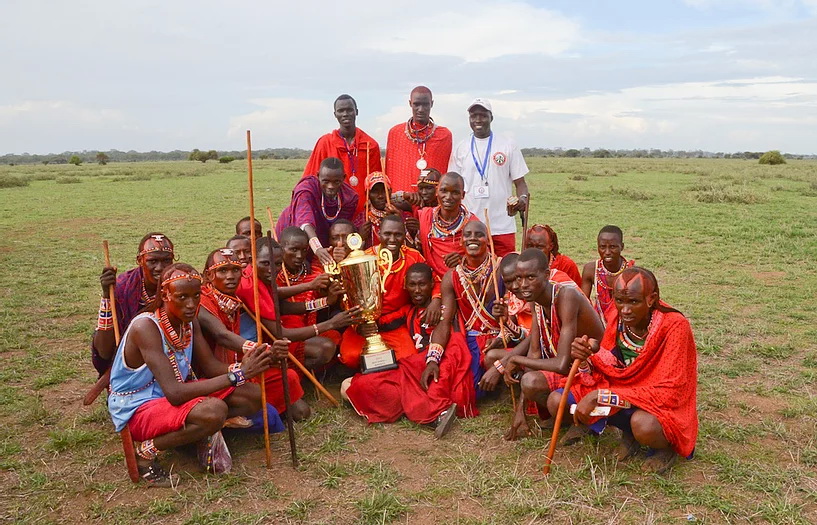
The Kenyan national television network NTV began a news story on the night of December 23rd with the words, “Something historic happened yesterday in the Amboseli-Tsavo ecosystem at the base of Mt. Kilimanjaro.”
What had happened was the first-ever Maasai Olympics – newly empowered young warriors competing among themselves not for how many lions they could each kill but for how many medals they could each win. As one of the Maasai “fathers of the warriors” – whose inspired dream had now become a reality was heard to say, “It was a day of trophy hunting in place of lion hunting.”
In order to witness history being made, a crowd of Maasai estimated at more than 3,000 came to a site in the Kimana Sanctuary, at the base of Mt. Kilimanjaro that had been transformed into a track and field venue decorated with colorful banners and flags.
The stated purpose of the Maasai Olympics – as originally envisioned by the “fathers of the warriors” – was to take lion killing out of the culture itself – once and for all, even making it a taboo – and to provide the warriors, as an alternative activity, athletic competition. At the organizing meeting in 2008, one of the elders said, “Why shouldn’t our young men compete for girlfriends, display courage, and show leadership like all the other young men in the world, through sports. But we need help from the conservation world to make this happen."
Maasailand Preservation Trust (now merging with the Big Life Foundation), who organized and administered these Olympics and served as a co-host along with Amboseli Trust for Elephants, and the Maasai Wilderness Conservation Trust, was most willing and able to provide that help since the inception of this grand idea in 2008.
Four of Kenya’s greatest track stars were on hand for this splendid occasion, led by the 2012 London Olympics gold medalist and world record-holder in the 800 meters, David Rudisha. David also happens to be a former Maasai warrior. The national and international media turned out in force to see and record this day when lion hunting and lion killing were indeed replaced in Maasai culture by athletic competition – for the first time in the 500-year history of the Maasai people in East Africa.
The Kenyan government’s contingent was led by the Honorable Katoo Ole Metito, Minister of Internal Security, who stayed for the entire seven-hour competition and presentation of awards. He later described the Maasai Olympics day as, “the best celebration of Maasai culture I have ever attended.”
The athletics competition was intense and of a high level of performance and the awards for the winners were dazzling in their value and variety. The five athletic events – based on traditional Maasai warrior skills – were spear throwing for distance, rungu (a small wooden weapon) throwing for accuracy, a 200-meter sprint, a 5,000-meter distance race, and high jumping – not the Olympics version but vertical jumping from a standing position, Maasai-warrior-style.
Four warrior manyattas (villages), representing a total community of 80,000 resident Maasai and more than 4,000 newly empowered Iltuati warriors, living on 1.6 million acres of irreplaceable wilderness habitat in the heart of the Amboseli-Tsavo ecosystem, competed for the ultimate prizes of a large golden trophy and a highly valued breeding bull that could be shared among warrior families of the winning manyatta, even if their sons were not on the team. The winning manyatta was Mbirikani with a score of 12 ½ points. Second was Rombo with 9 ½ points, Ogulului was third with 5, and Kuku was fourth with 3 points.
Cash prizes in excess of 250,000 Kenyan Shillings for the first, second, and third place finishers in the five events were handed out at the conclusion of the competition. David Rudisha also hung a handsome medal on the neck of each winner and stood for a photograph that will be treasured for a lifetime.
Other exceptional prizes and awards included a four-year university scholarship given in the name of Seamus Camp by Joy Smith’s North Star Foundation. Joy was also the Founding Benefactor of the Maasai Olympics. The winner of the 5,000 meters was given an all-expenses-paid trip to run in next year’s New York Marathon sponsored by AECOM and co-host MWCT – and the star athletes of Kenya who attended pledged themselves to help train the winner in their professional facility for the rigors of running the marathon distance.
The Chester Zoo presented their Wildlife Conservation Prize, to be used for student scholarships, to the Rombo manyatta for their conservation behavior in recent years in preserving all wildlife of the region, including rhino and elephant.
NGO sponsorship was led by the Big Life Foundation USA. African Wildlife Foundation and Chester Zoo were sponsors and co-host Amboseli Trust for Elephants made a contribution as well.
The lone tourism industry sponsor was Ol Donyo Lodge owned by Great Plains Conservation. Safarilink provided free airfares for the star athletes and Kenya Commercial Bank made a contribution toward the cost of the trophy.
The outpouring of enthusiasm for this first-ever Maasai Olympics expressed by these Maasai communities, and the warrior/athletes who participated, poses a strategic question to the conservation world: is your organization going to support this historic shift away from lion and wildlife killing to sports and trophy hunting – by making the Maasai Olympics an annual event on the Kenyan calendar - or will this daring dream of conservation by the Maasai people themselves simply be allowed to fade away?
This opportunity will not present itself again.
